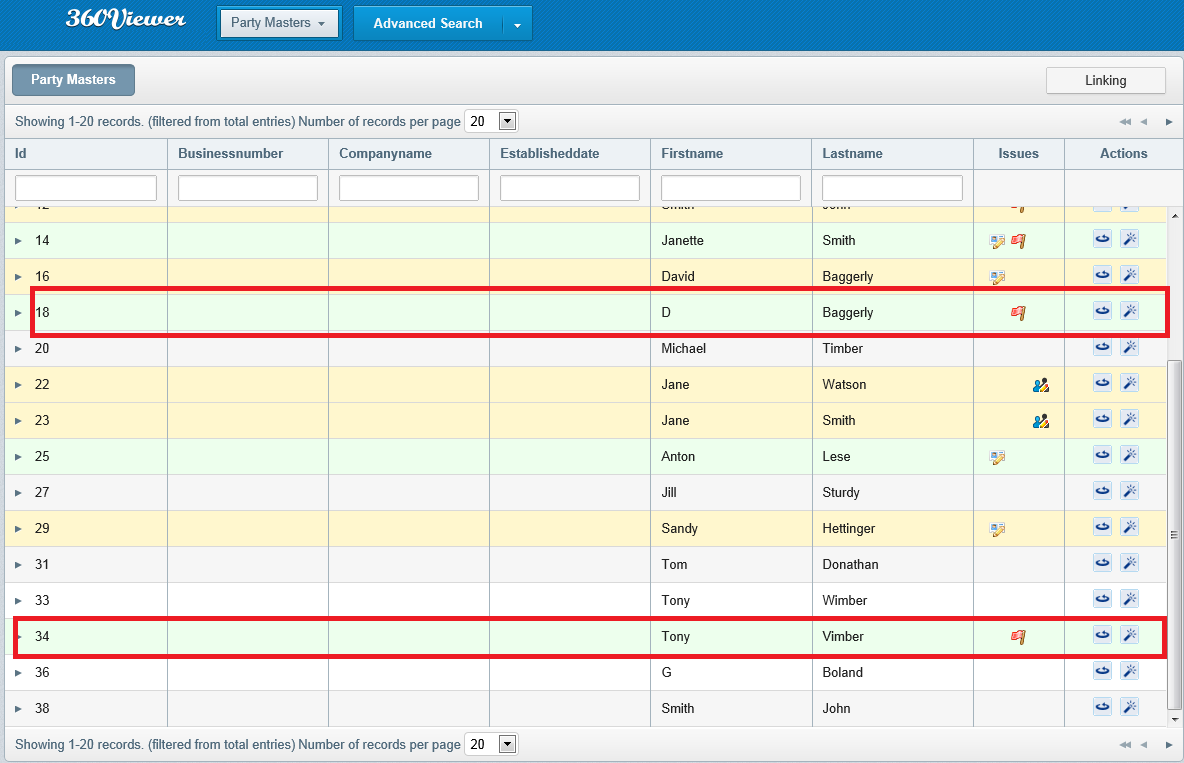General Issue Page (For Golden and Instance Records)
|
Topics: |
A General issue is the case that consists of the comments on attributes of the Golden and Instance record.
Note: This is the only type of case that can be opened by someone with a User role. User roles have all other Remediation pages prohibited for editing and viewing, but can be configured using the appropriate Policy.
Navigation Options
There are four options you can use to navigate to the General issue page:
- From the Details 360 and Master Comparison page, create a new General Issue case by clicking the General issue button (for Golden records).
- From the Master Comparison page, create a new General Issue case using the Open Ticket menu item (for Instance records).
- Through a link from the Issues pop-up window, you can view an already created General Issue case (appropriate icons are displayed on Details 360, Master Comparison, and Home pages).
- From the Issues page, you can view already created General Issue cases.
Note: Any record currently under the General Issue remediation may not be remediated under any other General Issue case.
If you want to open a General issue case for Golden record, navigate to the Master Comparison or Details 360 page of that record and click the General Issue button.
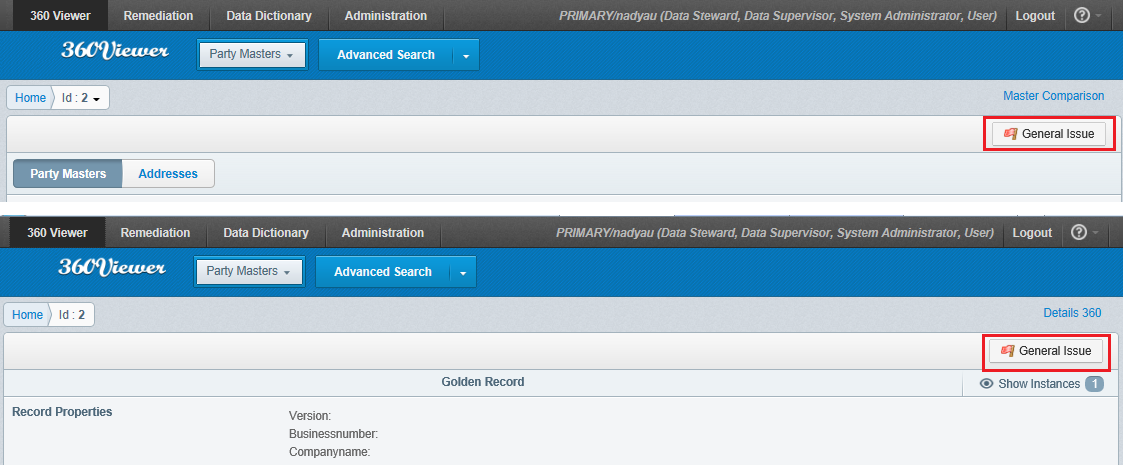
If you want to open a General issue case for the Instance record, navigate to the Master Comparison page of that record, expand the Instance records section, and select the Open Ticket menu item for the appropriate Instance.
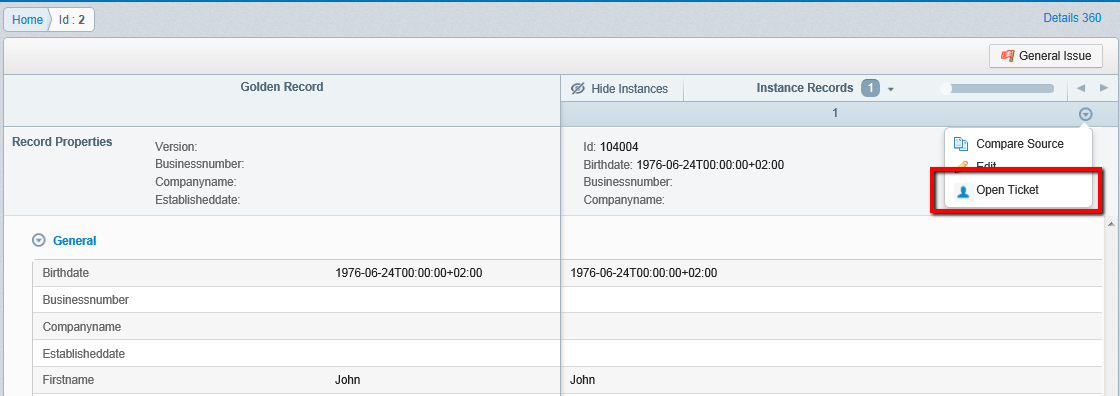
Another way to navigate to the General Issue page is through the links in the Issue pop-up window (if the General issue case already exists in the system).
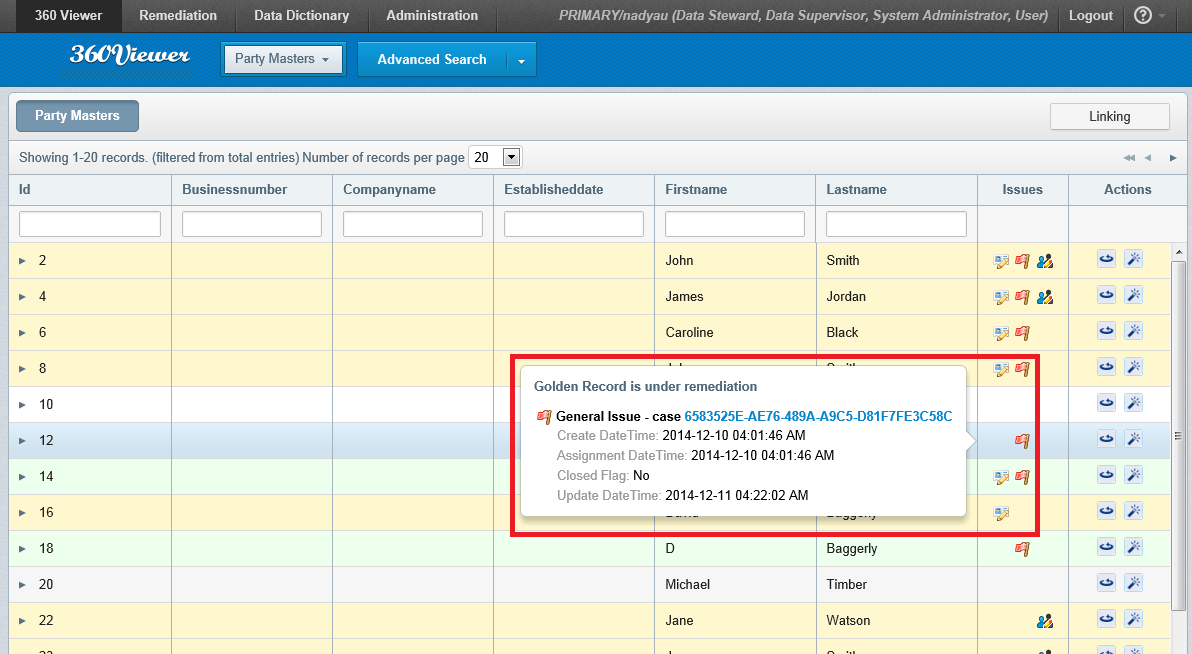
In order to see the pop-up window, move the pointer over any General Issue remediation icons that are displayed on Details 360, Master Comparison, or Home pages, and then click the appropriate link.
If a case is assigned to the current user, the General Issue page will be displayed in Update mode, so that the user can continue working with it. If it is not assigned to the current user, the General Issue page will be in Display mode, where the user can make no changes.
Note: If the General Issue case is created by someone with the User role, then the case stays Unassigned until the Data Supervisor or Data Steward assigns it to someone. Until then, the case can be edited by anyone.
The last way to navigate to an already created General Issue case is to select the appropriate link on the Issues page (not available for User roles).
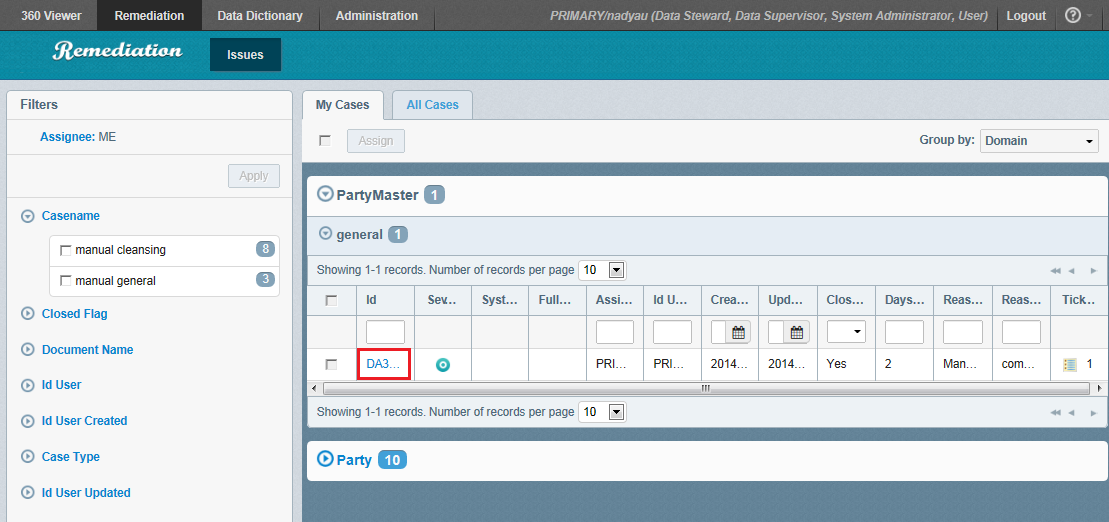
The same process applies as with links in pop-up windows. If a case is assigned to the current user, the General Issue page will be displayed in Update mode, so that the user can continue working with it. If it is not assigned to the current user, the General Issue page will be in Display mode, where the user can make no changes.
Note: Closed General Issue cases are displayed on the Issues page and in Remediation pop-up windows. Those cases can be opened in Display mode only.
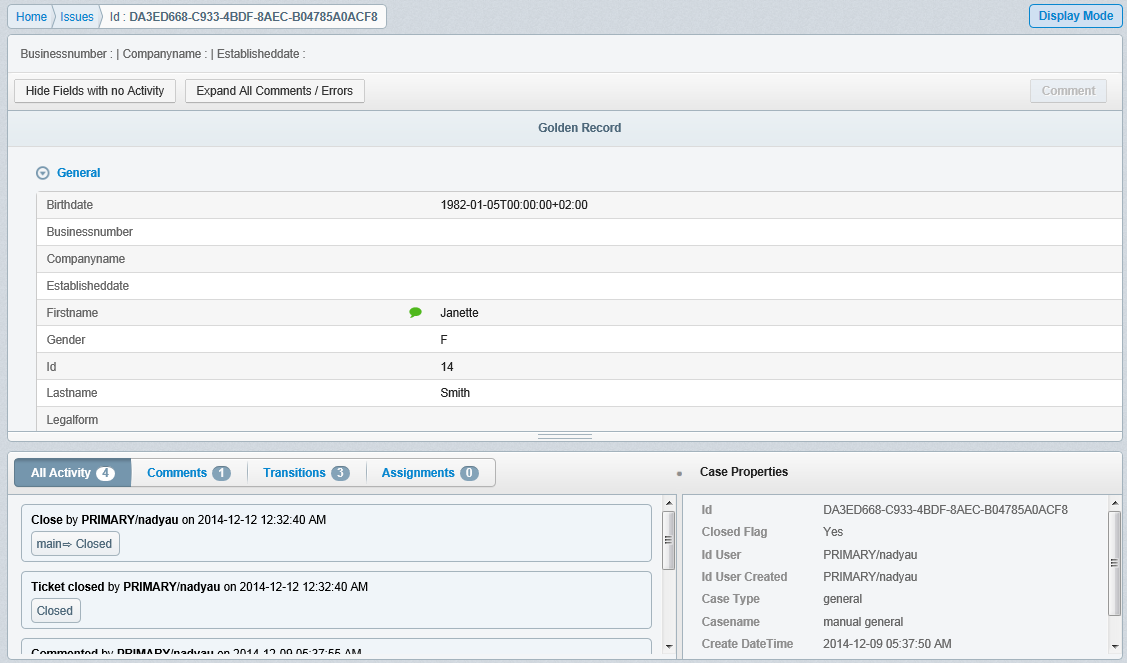
Page Structure
The General Issue Case page is composed of the following main blocks:
- Bread crumbs
- Workspace
- Expand / Collapse Workspace control
- Activity Stream
- Case Properties
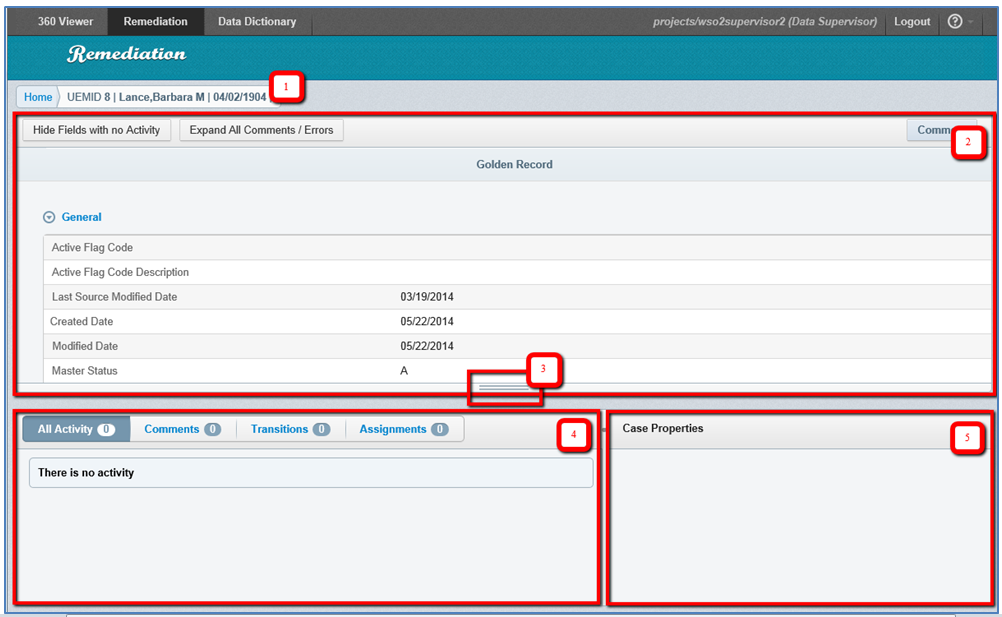
Using bread crumbs, you can navigate to the previously visited pages.
In the Workspace, you can add comments to attributes. By default, the workspace is collapsed and only the first main important attributes are displayed.
The fields of the Workspace panel can be configured using the Administration module. For more information, see General Issue Page.
The Expand/Collapse Workspace control shows and hides the Activity stream and Case properties, and expands/collapses the Workspace. When the workspace is expanded, the Activity stream & Properties link is displayed in the bottom-right corner of the page to open the Activity stream and Case properties sections.
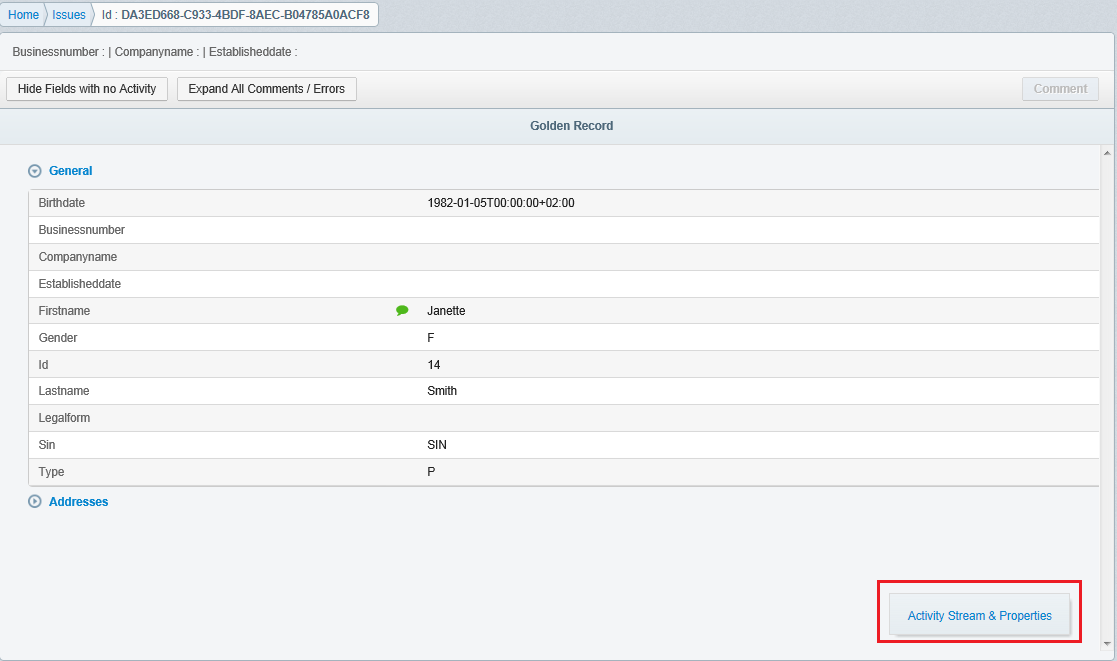
Below the Workspace, the Activity stream is displayed. All activities such as comments and transitions through the workflow for every attribute, general comment, and reassignment issues are tracked in the Activity stream.
Case properties include information on the case (for example, assignee, created date, and so on).
Creating a Case
In order to create General Issue case, comments should be added to any field. After the case is created, the Activity Stream and Case Properties sections get refreshed, and displays the relevant information (the Case Properties section can be configured using the Administration portal). For more information, see Case Properties Panel.
The following image shows the Workflow actions drop-down list that appears (only for Data Steward and Data Supervisor roles).
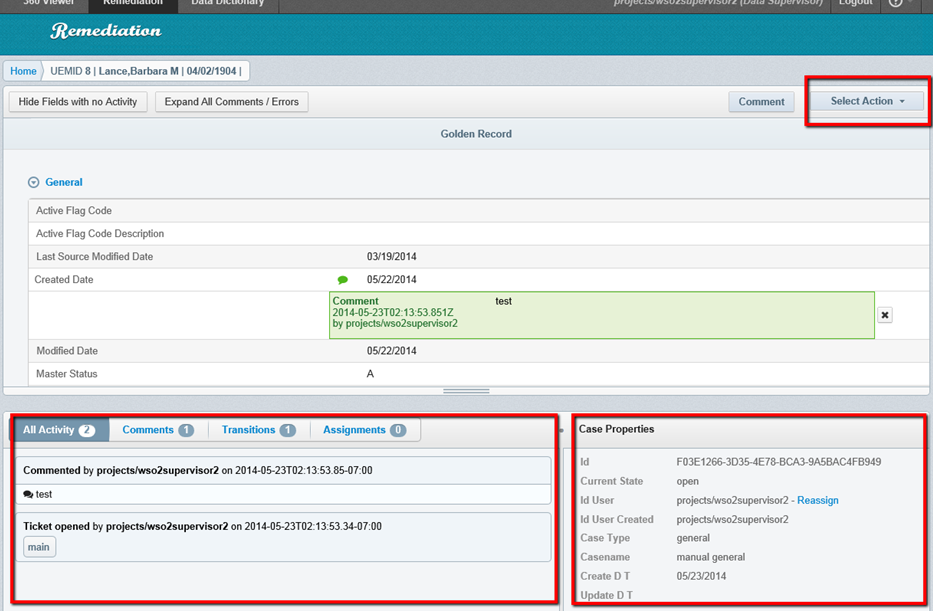
Note: A User role cannot send the case to the workflow, so the Workflow actions drop-down list is not displayed for this user.
You can comment on any data attribute. When you move the pointer over the Original Data value or label, the Add comment icon is displayed. When the you click on the icon, the Add comment overlay is displayed.
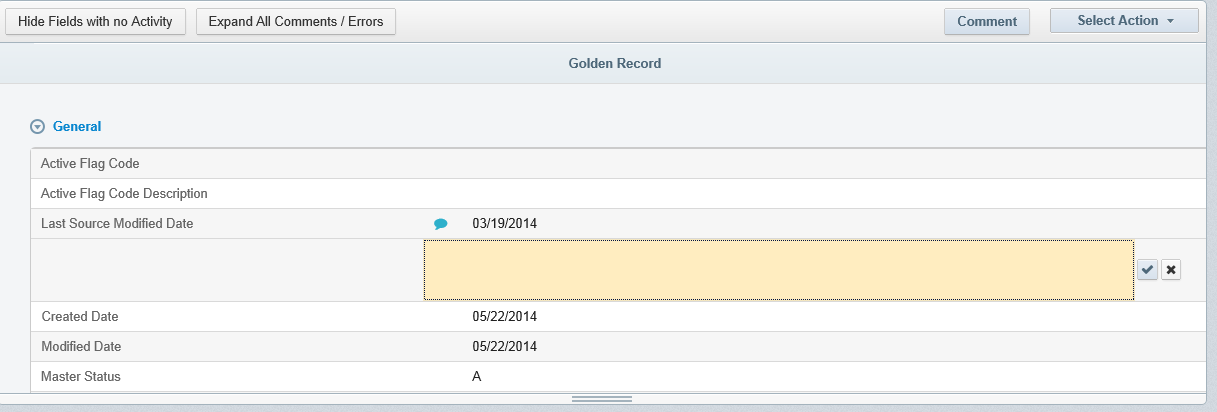
You can enter text and save a comment by clicking the Save icon. The comment will then be displayed in the Activity Stream and can be viewed when clicked on the Add a comment icon (the comment will be displayed in the expandable area below the row).

Note: When a comment is not saved yet, the Add comment icon is blue and the comment box is yellow. When the comment is saved, the icon and box both turn green.
Comments for attributes can be updated or deleted. In order to update an already saved comment, click anywhere in the Comment box and the comment text will be editable again. If you want to delete an in-line comment, click the Delete (X) icon.
You can optionally enter a global comment for the whole case by clicking the Comment button. It will appear in the Activity stream.
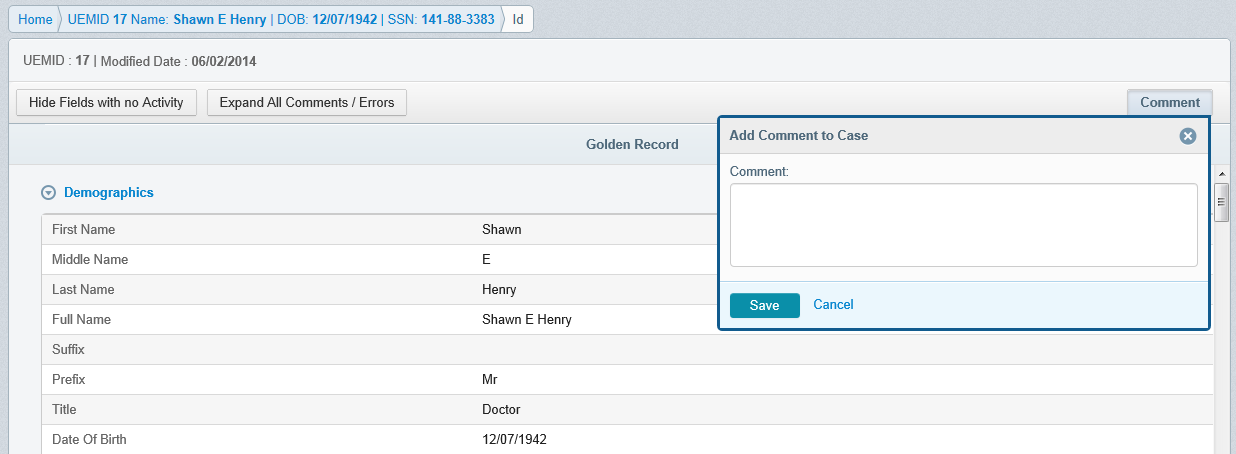
Viewing Comments
To view only attributes that need actions from a user, you can use the Hide Fields with no Activity switch. When the switch is activated, only those attributes are displayed that contain the following:
- Have manual edits.
- Have comments.
- Have issues (errors) from automated processes.
For convenience, the you can expand all the comments, errors, and notifications for all attributes using the Expand All Comments/Errors button.
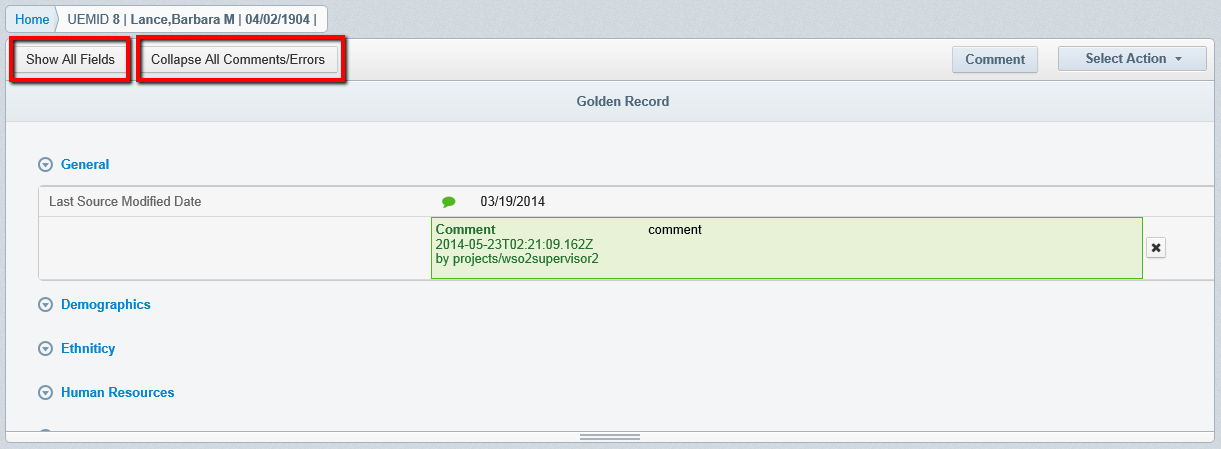
Once clicked, the buttons change their names, from Hide Fields with No Activity to Show All fields, and from Expand All Comments/Errors to Collapse All Comments/Errors so you can decide what exactly you wish to see.
When you have some unsaved changes made on the page, and try to navigate outside of it, a warning dialog box will appear, as shown in the following image.
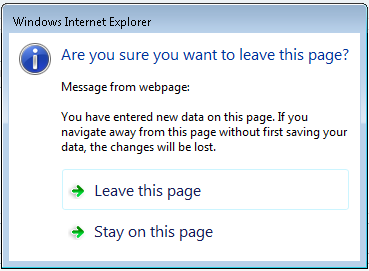
A created General Issue case is displayed on the Home page accordingly, as shown in the following image.
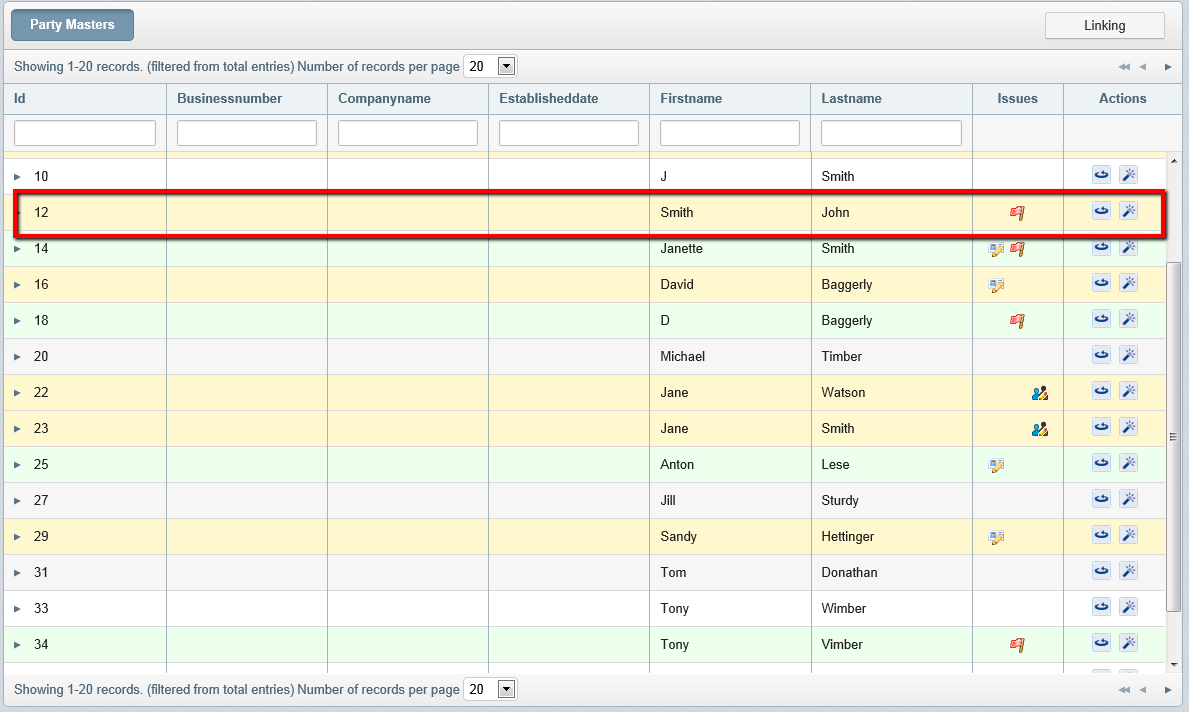
The row with an opened case is highlighted in amber, and the appropriate icon is displayed.
Reassigning a Case
If you want to reassign the case to someone else, click the Reassign link in the Case Properties panel.
Note: The Reassign link is not available for closed cases.
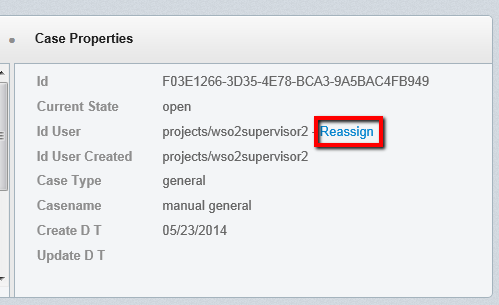
If there are any unsaved changes on the page, and the Reassign link is clicked on, then a warning dialog box appears, indicating that a case with unsaved changes could not be reassigned, as shown in the following image.

When there is no unsaved data and the link is clicked, the Reassign dialog box appears. The functionality of it is similar to the Assign dialog on the Issues page.
Note: For User roles, the Reassign link is not displayed, preventing you to reassign the case.

A list of users is available in the Assign to User drop-down list. When you start typing in the field, data becomes filtered dynamically to display only the relevant information.
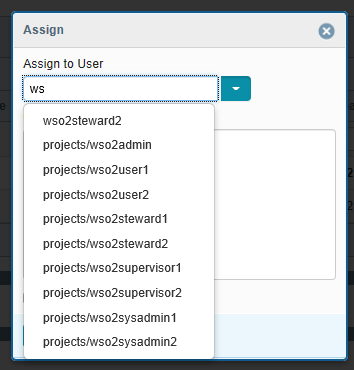
If the case cannot be assigned to the user selected from the list (for example, because the selected user has no permissions to resolve cases, and so on), or the entered data finds no matches in the database, the appropriate validation message is displayed, as shown in the following images.
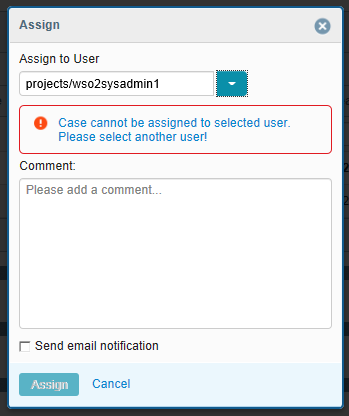 |
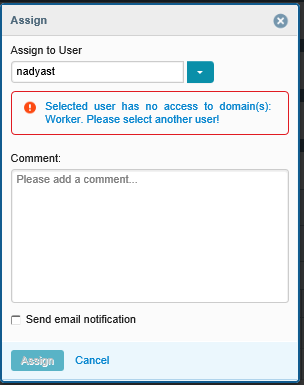 |
If the selected user is valid, the Assign button becomes available and case(s) can be reassigned.
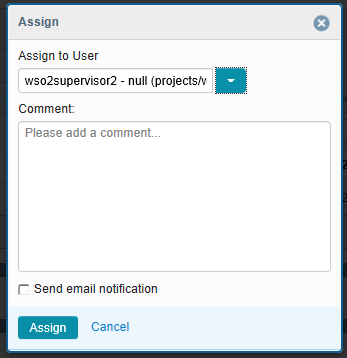
After the Assign button is clicked, you are redirected to the Issues page because case is no longer your own.
Note: If you want an assignee to be notified about the reassign activity, the Send email notification check box should be selected.
In order to submit a case to the workflow (only with Data Steward or Data Supervisor roles), select the appropriate workflow action from the drop-down list and click Submit (the Submit button appears after a workflow action is selected).
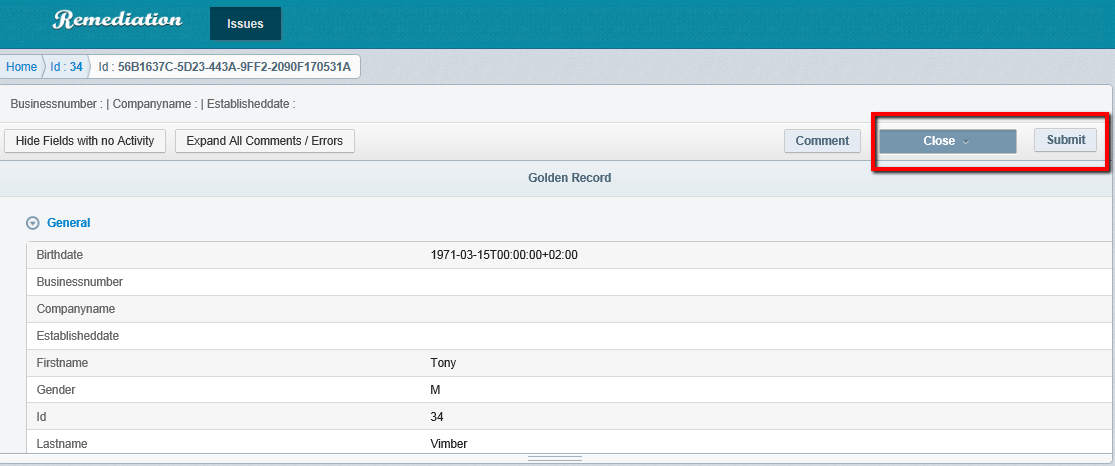
When a case is submitted, the appropriate notification will appear in the upper right corner of the screen, as shown in the following image.
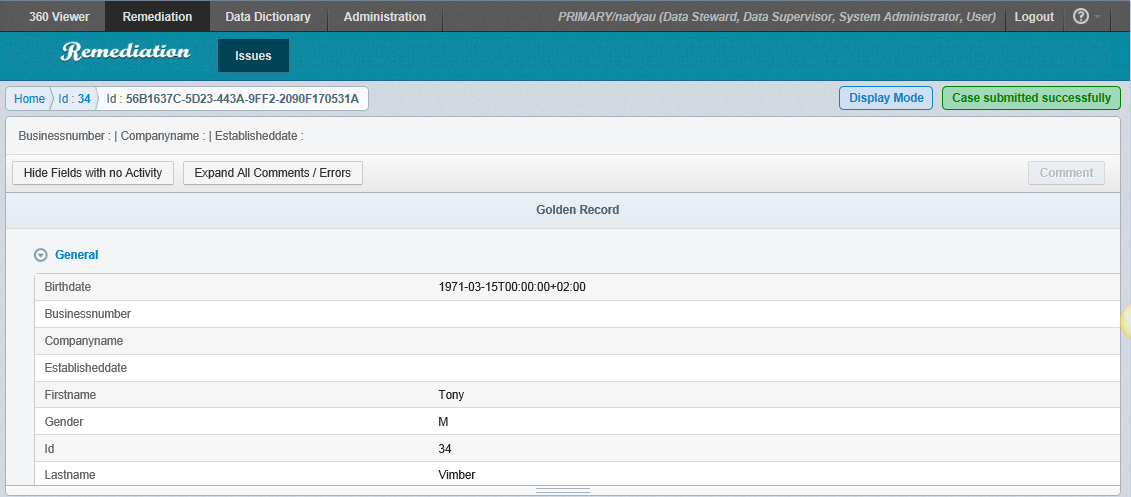
Workflow Schema
The Workflow actions available for each edit are dependent on the User Role and the current status of the edit. The Workflow schema is shown in the following image.
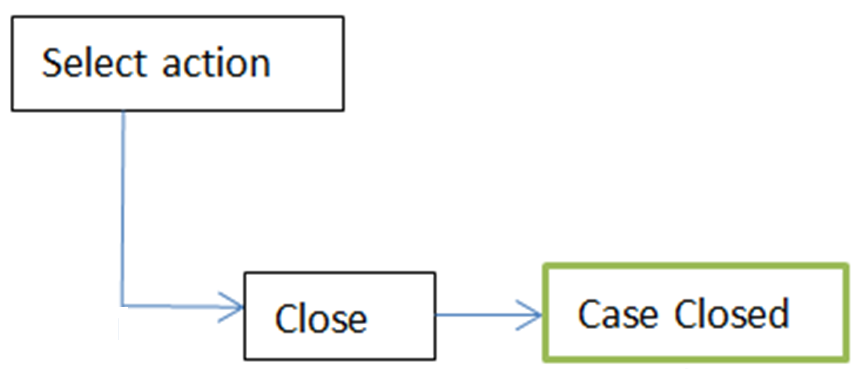
Workflow actions available per role are displayed below:

When the case is closed, records that were under the General Issue remediation process are highlighted on the Home page in green color. The New General Issue remediation process can be started for them.
